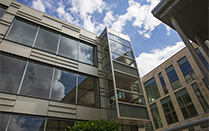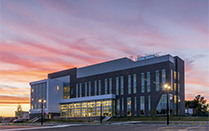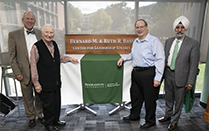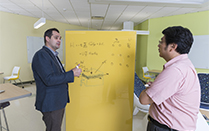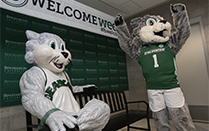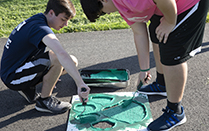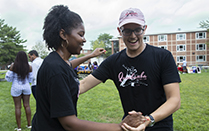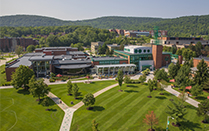Binghamton Senior Survey process showcased nationally
The Senior Survey, which collects information from graduating seniors about their post-Commencement career plans, launches in early April each year, but has had a large increase in response rate and the quality of the data due to a number of creative initiatives taken by the Office of Student Affairs Assessment and Strategic Initiatives (SAASI).
Using Campus Labs software, developed by alumnus Michael Weisman ’98, SAASI made some improvements. “We used their software in a different way than we had before,” said Chris Knickerbocker, SAASI director. The survey is normally sent with a link that is particular to the student and was personalized by each school. Because students don’t always respond to e-mails – or forget if they have responded – SAASI created a different kind of process to generate a URL and QR code that the students can use wherever they are − with the help of Campus Labs
These efforts were showcased at the National Association of Student Personnel Administrators Conference (NASPA) in March, in a joint presentation with campus and alumni partners including Weisman; Vice President for Student Affairs Brian Rose; Denise Lorenzetti, director of Watson career and alumni connections; and Knickerbocker, who said there was a great deal of interest from attendees about replicating the process on their campuses.
The presentation focused on approaching the process from gathering knowledge − not just survey responses. Binghamton’s unique approach involved partnering directly with schools, including a competition for the highest response rate, and determining where to gather additional information. “We created events like free LinkedIn photo sessions and stood there with laptops to catch students,” Knickerbocker said. “We also went to events like the senior brunch and contacted the schools to see if they had any gatherings. We went to where students were getting on the bus, stood outside of the bookstore, put notices in all of the cap and gown pick-ups. We had the schools send it out on listservs. We were reaching out in many places.”
Knickerbocker’s goal is to increase the response rate again this year. (It rose from 39 percent in 2012 to over 70 percent in 2013.) To do that, SAASI is targeting larger departments as well as departments that had lesser response rates in the past. Her expectation is that some schools will have a 100 percent response rate this year.
“We are doing some really creative things this year,” she said. “We look at it more as a knowledge response, not a survey response. We’re gathering answers to the large questions: ‘What is your path?’ and ‘Are you moving along that path?’”
“We’re looking for those pockets of information and reaching out to faculty about students who may not have responded to the survey, but who might have notified them about getting a job,” she said. “We’re accessing national databases, having a video contest for Harpur College students about what they’re doing after they graduate, using Twitter and trying to get information from a lot of sources.”
Though it may sound as if SAASI is everywhere, the partnership it has created with the schools help make it happen, said Knickerbocker. “We formed partnerships with each one and they become our information gatherers,” she said. “The schools are invested in it from a competition standpoint, but also the more data they have the better. SAASI does the analysis and they end up with information they can use to their advantage.”
